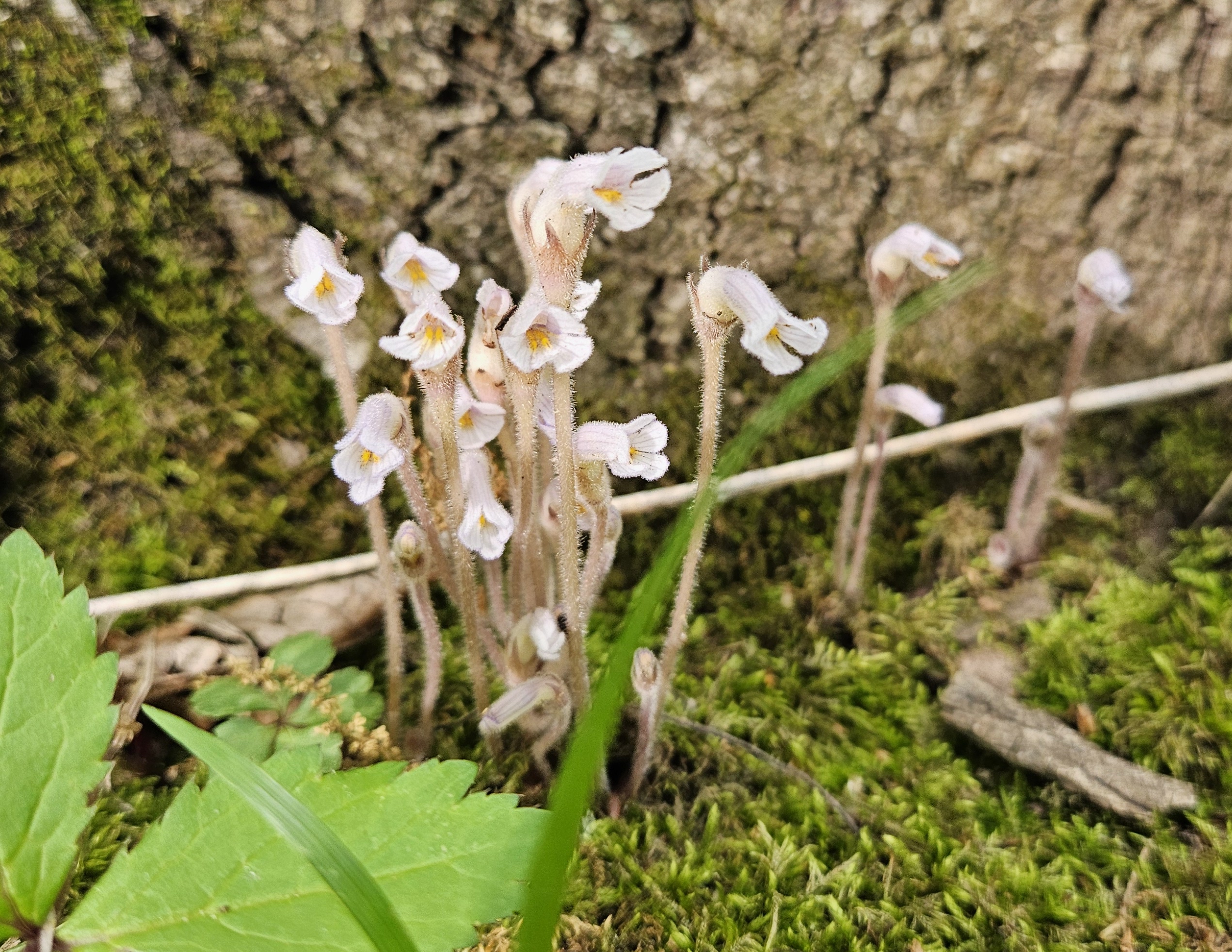Spring wildflowers are exploding, Iowa’s longest drought in decades is abating, and Bleeding Heartland’s wildflowers series returns today for its thirteenth year.
As grateful as I am for the rain, the warm, wet spring weather is boosting some invasive plants as well as native ones. I’ve pulled up enough garlic mustard over the past couple of weeks to fill several garbage bags, but I’ve hardly made a dent in the wooded area closest to our Windsor Heights home. Something blooming out there is triggering my spring allergies as well.
Emily Bredthauer gave me permission to publish a selection of photos she took in April and May at Margo Frankel Woods State Park in Polk County. I’m always excited to share images of a plant I’ve never seen before, and Emily was fortunate to find some naked broomrape (Orobanche uniflora), an unusual parasitic plant shown above, and in a few pictures below.
Please let me know if you would like to write a guest post for this series, either featuring one kind of plant or a selection of wildflowers seen in one location. This Iowa wildflower Wednesday archive is alphabetized by common name of the plant. Last year I compiled links to previous posts featuring many plants encountered during visits to parks, prairies, natural areas, or trails.
Emily took all of these photos at Margo Frankel Woods. Saylor Township manages the park, which is named after Margo Frankel. She served on the state Board of Conservation in the late 1920s and 1930s, when Iowa was developing a state park system.
Going in chronological order, here are some of Emily’s pictures from early April. Dutchman’s breeches are often among the earliest flowers to bloom in Iowa woodlands.

Hepatica is another early bloomer. In the lower left area of the frame, you can see leaves from last year, which store food and facilitate the early flowering period.

Common blue violets are appearing.

And cutleaf toothwort is blooming as well.

Virginia bluebells have lots of buds but few flowers.

Spring beauty flowers are often closed in the morning and evening.

By mid-April, Emily was finding lots more bluebells.

As well as some trout lilies, which are also called dogtooth violets.

Here’s a white color variation of the common blue violet.

And some downy yellow violets blooming alongside Dutchman’s breeches.

Littleleaf buttercup is easily overlooked.

Whereas bellwort (sometimes called large-flowered bellwort) is eye-catching.

Some flowers on Virginia bluebells can be so pale they almost look white.

Also in mid-April, sweet William (also known as wild blue phlox) is becoming more prevalent.

Emily found a rare sweet William flower with nine lobes instead of the usual five. (For some reason, they are called lobes rather than petals.)

By late April, Emily found wild ginger blooming at Margo Frankel Woods. You often have to crouch down to see these flowers under the leaves.

The same goes for Mayapples, also known as umbrella plants because of the large leaves that can obscure the flowers.

By early May, the spring beauty flowers were mostly gone, but seeds were starting to form inside capsules on the plants.

In contrast, Solomon’s seal is not blooming yet, but recognizable by its leaves and curved stem.

Here’s a Jack-in-the-pulpit blooming, with mayapples in the background.

Emily’s most exciting find from early May was naked broomrape. To my knowledge, I’ve never seen these. They lack chlorophyll, like another parasitic plant usually called Indian pipe or ghost flower.



Emily caught some white baneberry blooming too. Last year, Beth Lynch featured these plants and their berries.

Closing out with a couple of flowers that are much more often found in Iowa woodlands: hispid buttercup or swamp buttercup.

And Virginia waterleaf, sometimes called Eastern waterleaf.



1 Comment
Yay, first Wildflower Wednesday!
Laura and friends, thank you for taking readers to places where we can see wonderful flowers even when we can’t be there in person. And thank you to all the WW fans who are working to control invasive exotics.
PrairieFan Wed 15 May 8:34 PM